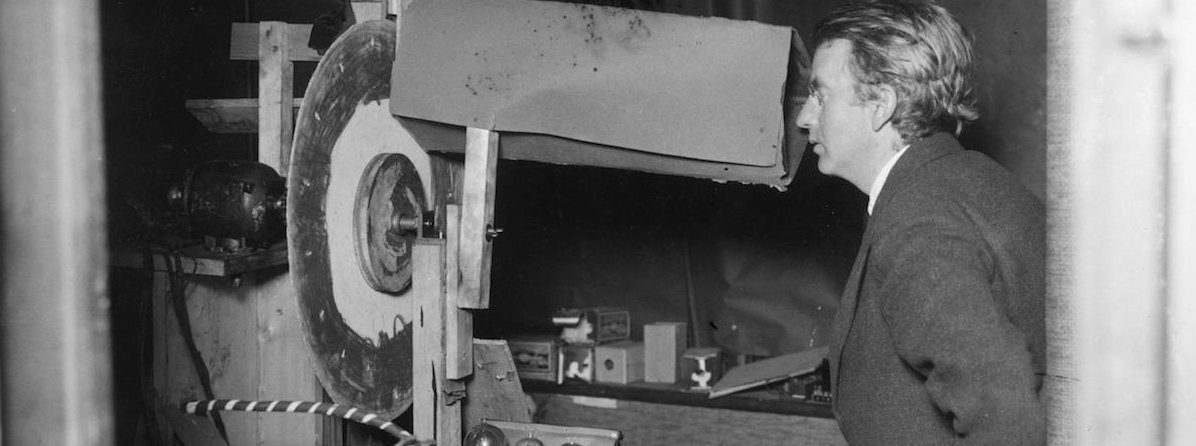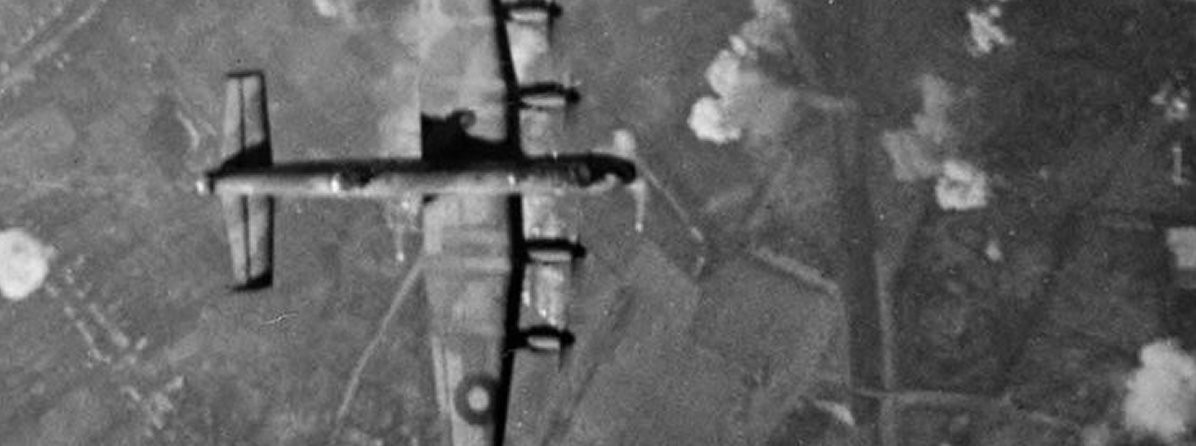
John Logie Baird - Television, Secret Experiments, Sabotage, Lies - Chapter 5
Jhn Logie Baird - Chapter 5: Marked "Classified"
Following the fire at the Crystal Palace, it took the Postmaster General three months to confirm Baird's fate by announcing that the Television Advisory Committee had recommended termination of the dual-transmission period, and that a single standard -Marconi-EMI's single standard, would be adopted. On Saturday 13th February 1937, viewers watched the last Baird programme, A Half Hour of Variety. After years of pioneering work, Baird was effectively out of television. Ostrer considered withdrawing his support for the Baird Television Company, but Baird, who always managed to bounce back with an even more advanced system than the last, emerged from his laboratory a few months later with another big screen projector, capable of supplying colour.
A new company was formed, Cinema Television, with a plan to send out live scenes to cinemas throughout the country. Big screens were installed in several Gaumont cinemas, and a number of topical events were transmitted, drawing large crowds. Baird demonstrated colour television at the Dominion feeling that the future of broadcasting lay in colour rather than monochrome. (The first mention of colour television came in 1928 when Baird's biographer, Ronald F. Tiltman, claims to have seen what he later described as a; 'striking demonstration in which the vivid reality of the colourings seen on the receiving screen was quite remarkable.' Six years later Baird was confident enough in this system to demonstrate colour television to the Selsdon Committee). By early 1938 Baird was invited to Australia to address a World Radio Convention and with his wife and two children he set sail in February returning in time for the Radio Show in August, where he had a large exhibit, showing off a 26 inch cathode ray tube television receiver, the largest available at that time.
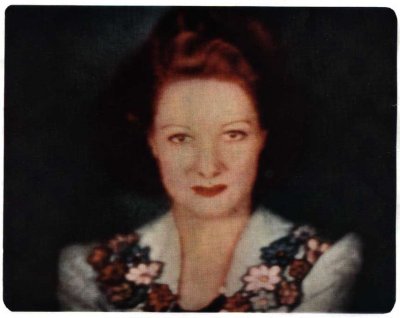
By now, ominous threats of war were looming and within a month the Prime Minister, Neville Chamberlain, was addressing the British public from the cabinet room at 10 Downing Street, by radio, to make his historic announcement that Britain was at war with Germany. Forthwith, all television broadcasting was stopped, the official line being that the BBC transmitter could act as a guide for enemy aircraft. For the Baird Company, who was ready to swing into production to fulfil an order of fifty large-screen systems priced at £2,750 each, the war could not have come at a worse time. The company had just spent £1.5m on developing television equipment, but with the cessation of all broadcasting, bankruptcy was only a matter of time. By August 1940 a receiver was appointed.
At the outbreak of war Baird evacuated his family to Bude in Cornwall with a promise that he would follow on in due course. In fact, he never did. He received numerous offers to go to America but turned these down to apparently continue his work at his home in Sydenham. However, a recently discovered folder marked Baird Television Limited containing numerous documents proves beyond doubt that in 1940 Baird was working on an aircraft to ground television system for the French Air Force. The folder is No. 101, issue 1, dated January 1940 and comes from the estate of B.B.Austin who worked on the project. The system used the Baird intermediate film method by means of which a moving picture of the scenery below the aeroplane is taken on a 16mm film, rapidly processed and then transmitted to a ground receiving station. The folder consists of some 125 pages detailing how to use the system, all the circuit diagrams, ten original photographs of the equipment used, and five strips of original developed negatives of film taken at the time of the experiments.
In 1986, Jeffrey Cohen made an enquiry to Thorn EMI about Airborne Television Equipment. The reply was as follows:
'The first equipment was supplied to the French Air Force in 1937 and was fitted into a French bomber at Hendon. The receiving equipment was fitted into racks, with a repeater monitor in a table-top display - that is, the screen of the display tube was horizontal.
Further equipment was supplied to the British forces in 1939. It was a redesign of the 1937 equipment and operated on 400 lines, 25 frames non-interlaced. A sophisticated and very effective form of automatic gain control was fitted, derived from experience with the early BBC outside broadcast links. The camera and transmitter were fitted into an Anson Coastal Command bomber/reconnaissance aircraft, and provided with two cameras, one a vertical camera in the bomb aimer's position, with aiming from a joystick in the observer's position, and the second mounted in the gun turret to give oblique views. The receiver again provided for table-top display which could be set so that north could be aligned appropriately. One receiver was supplied to the Army, and was prepared to be demonstrated to Churchill on Horse Guard's Parade, and the second was installed in HMS Iron Duke.
Good pictures were received from aircraft at a range of 80 miles.'
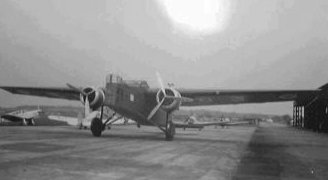
A February 1985 article in Radio & Electronic World, by Ray Herbert, a member of the Baird team throughout the series of flights, went into more detail of the equipment and the results it achieved: 'The full potential of the system, particularly the possibility of using infra-red devices, could not be exploited due to the abrupt termination of the work after the outbreak of World War II.
After initial test flights from Hendon Airport early in 1939 to establish transmission coverage, pictures of the countryside around West London were radiated regularly during July of that year, sometimes twice daily. In August the aircraft returned to its base at Villacoublay near Paris and further transmissions were made while flying over northern France.
Results were most satisfactory. At a height of 4000ft those on the ground could discern quite easily white markings on tennis courts, ripples on the water of reservoirs, and even names on buildings.
A Marcel Bloch 200 twin engine night bomber (No ED83) with a flying speed of 150mph was used to carry the equipment. The crew consisted of a French pilot and mechanic and three Baird engineers. Because the equipment lacked definition in poor light it was decided to use Baird's intermediate film process.
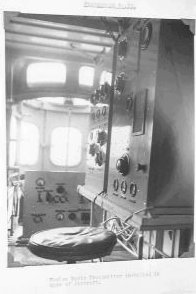
'This arrangement had already been in use for transmissions from the studio and involved developing and fixing the film in 16 seconds, then passing it 'wet' through a cathode ray tube scanner for conversion into television signals. The adaption of this bulky equipment for use in an aircraft posed many problems in connection with size, weight, power supplies, change in air pressure and vibration. This system had the unique advantage that at the termination of a 30-minute flight, 45000 individual pictures of the ground were available on film for detailed analysis. Messages and sketches written on transparent material could be placed in a holder immediately beneath the scanning tube and transmitted the same way as the film. '
It is known that similar projects were in progress in 1939, but due to the secret nature of the work very little information has emerged. After the outbreak of war the bomber moved from Villacoublay to Orleans and later Toulouse. Its ultimate fate is unknown, but it almost certainly fell into the hands of the Germans.
In 1986, Jeffrey Cohen approached Christopher Lee, the BBC Defence Correspondent and asked if he'd hear anything about Baird's work during the War. To his great surprise he had come to just the right person:
'My father-in-law, Reg Adams, was in charge of a secret project using TV and he had frequent meetings with Baird at Whaddon Hall (the MI6 radio station in Buckinghamshire) - I think. Only two other people knew about the project so you will find it hard to get anything, and you may rattle a few skeletons. My father-in-law died two years ago but he had spoken of the project a few times. He said it had unprecedented secrecy, even as wartime projects went.
He made two trips to RCA Indiana in '42 and '43, I think. He flew the family to Chicago, and had to take cash to pay for the RCA equipment (because) they did not even trust a bank. Reg ran an amateur radio company called Webb's Radio before the war, and he was a very early TV enthusiast and knew Baird. In 1942, he and Jerry Timms were drafted into SOE (Special Operations Executive) to start a new radio section.'
As a result of this information, Jeffrey Cohen was able to track down James Timms, who started a company called British Communication Corporation. The company was formed by members of the Polish radio section of SOE using designs they had perfected during the war. They only made military equipment. When pressed, Timms refused to give anything away apart from the fact that he knew Baird was involved in something they were doing. When Jeff mentioned he had spoken to Christopher Lee, Timms expressed surprise that Lee knew about it. Jeff then went back to Lee who suddenly decided that he no longer wanted to help. His mother-in-law, said Reg, had told her the project must always remain a secret and she must respect this.
Jeffrey Cohen later spoke to Stanley Radford who had personally known Baird. He said he had a very high opinion of the inventor and wasn't in the least bit surprised he was involved in secret work during the war. He confirmed that Baird was involved with 'think tank' sessions at his Sydenham home which were run by Robert Renwick (Chairman of the London Electricity Board and Lord Bowden of Manchester University). Radford was in a government department that vetted scientific work during the war and said Baird was one of a group of leading scientists who advised government on a variety of subjects. Jeffrey Cohen drew his own conclusions from his research. It is his belief that there was a plan to use TV in a secret operation - probably inside Germany. The difficulty in gaining information is due to the fact that it involved Secret Intelligence Service (MI6) rather than Special Operations Executive. Jeff thinks that the project was long in the planning but for some reason never carried out. 'The most likely aim was intelligence gathering from information sent in the form of a TV signal. Baird would have been indispensable for his detailed knowledge of German TV. However, such a project would only have needed receivers, and these were made in Britain, but RCA was known as a manufacturer of small TV cameras (they produced some 8000 during the war predominantly for the US Airforce, but some for the Army and Navy, but their uses have never been fully revealed).
After the liquidation of the Baird Company, Baird himself experimented independently on 3D colour television. Screen sizes ranged from 24 to 30 inches and were transmitted as a 600-line image interlaced six times. Some of the 3D systems he demonstrated did not require the viewer to wear special glasses. This too was not a new idea. The first demonstration of 3D television (or stereoscopic television as it was then called) was made to a selected audience on 9th August 1928, one month after Tiltman claims he saw colour TV. Writing for Television in September of that year, Dr. C. Tierney wrote an account of that demonstration: 'A man sitting before a transmitter was very clearly seen on the screen of a receiver situated in another part of the building, in perfect relief, showing the facial delineation and expression both with and without optical assistance. These experiments promise considerable development and importance in their practical application.'
But once again these experiments and inventions were not made simply for their entertainment value. The Admiralty soon took out a series of 3D radar patents that bore a striking resemblance to Baird's 3D colour television. Baird continued his secret experiments. Not in his Sydenham residence but in the burnt-out ruins of the Crystal Palace. At the outbreak of the Second World War the British government ordered the demolition of all non-essential large buildings for fear that these structures would act as markers for enemy aircraft. As the Crystal Palace was now in ruins and no longer serving any purpose it was reasonable to expect the two towers to be taken down. However, when Mr Felix Levy, a top official of a demolition firm involved in the clearing of London's skyline was called up to the Ministry of National Security, he was told that on no account were the towers to be touched. In a letter to the New Scientist in 1976, Mr Levy wrote: 'Some years afterwards I was told by the same officials that the reason for the demand by the Ministry was that J. L. Baird was working on top secret projects, for which one of the towers was used.'
These 'top secret' projects may have involved Baird's continuing work on radar -but there is another possibility. We have seen how Baird's work always seemed to come to light years after he'd actually created it. The suggestion is that he used the publicised work as a smokescreen to draw interest away from the project he was really working on. By the time rumours were circulating of his involvement with radar, Baird was probably working on another vital area of research...secret signalling.
'The inter-allied intelligence operation Enigma' - wrote a prominent American historian of cryptography - was 'the greatest secret of World War II after the atom bomb'. The secrets of the Enigma, the German cipher machine, which gave rise to Ultra, for breaking the German codes, remained hidden and unknown to the public for almost three decades. Axis cipher communiqués were turned into plain language and then translated, before being sent to decision-makers like Winston Churchill and his chiefs of staff and to various military commands throughout Europe and the world. But it's possible that Enigma may not have been the greatest secret after all. That may have been a British invention.
Enigma had one particular drawback, and that was its speed. Even using the most sophisticated of equipment available in those days, only 80 words a minute could be transmitted by radio. But by 1944 the British were using a system that was over 9,000 times faster. Television.
In December 1941 John Logie Baird accepted a consultancy with Cable and Wireless, the crown corporation that controlled all official communications in Britain, at a salary of £1,000 a year. The story put out by the company chairman, Sir Edward Wilshaw, was that this contract was to help Baird maintain his private television laboratory. But Baird's specialty at Cable and Wireless was facsimile television, the transmission of printed or filmed material at extremely high speeds. By 1944 Baird was recording and replaying typed material recorded on cine film, and one cine film frame could contain one printed page of up to 500 words. At 25 frames a second this meant that Baird could transmit 750,000 words a minute, and by altering the interlacing of the camera, could scramble the message for added security.
Baird had previously experimented with such systems in Britain, but also in Germany. Remember that the Baird Company had business ties with Fernseh, and under the agreement of their partnership exchanges of technical information were mandatory? The wartime story of that particular company reveals some startling facts. As allied bombers flew over Berlin in 1944 so the main Fernseh works were moved to the relative peace of Obertannwald in Czechoslovakia. The name of the company was changed to Farvis and they were set a series of tasks, one of which was to find a way of sending maps via a high-resolution system. Transmitters were built of different wavelengths and experiments were carried out on developing a rapid-picture transmission system. There is no doubt that whatever experiments the German engineers were working on, so were their English counterparts. However, if the systems were based on Baird's own designs, then the British had one distinct advantage: the inventor himself.
In Britain in 1939, Dr. Rosenthal had applied for a patent for secret signalling by television. A year before that Rosenthal had suggested the use of a new kind of cathode ray tube for the recording of electronic signals. The properties of this new screen left a dark trace, which remained for a long time. Although this rendered the system unsatisfactory for the normal transmission of television pictures, it provided a means of holding a visible image on the screen long enough to be studied at some length. This signal could also be transmitted in a split second before being halted, meaning that it was almost impossible to detect. The new tube was called the Skiatron or dark trace tube (a cathode-ray tube used in radar) and was incorporated into the radar system for aircraft tracking. According to a former Baird assistant, the Baird Television Company had a Skiatron production line at Lower Sydenham.
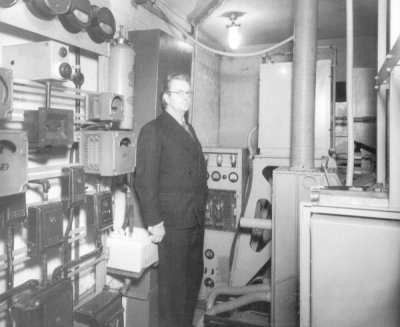
At this point it is interesting to note an entry in John Logie Baird's personal diary. On the 10th July 1944 Baird wrote: 'Gee to send (night!) letter USA re Fernseh.' The entry obviously refers to the company that he had so many dealings with before the war and was now employed in carrying out its own secret experiments. It is interesting that Baird uses the term 'letter' rather than 'message'. Was this to be sent using a method of facsimile? The transmission of documents, diagrams and photographs over a telephone network didn't come into everyday usage until the mid-1980's, but Baird had demonstrated the ability to send printed documents by television much earlier than this. In 1928, during the public demonstrations of his Televisor, Baird passed a Daily Mail contents bill slowly before his transmitter for those watching the receiving screen. The following day the newspaper ran the following article: 'A Daily Mail contents bill was seen at a distance through several brick walls yesterday at the public demonstrations of the British television system which are being given during Radio Exhibition week at Olympia, Kensington.'
On 1st June 1976, a Mr. James G. Heath wrote a letter to Helensburgh library, which stated that in 1928 and 1929 he was stationed at the newly built Mons Barracks in Aldershot, where he was detailed to help a lieutenant in the supplementary reserve of officers, lay field cables. Mr Heath claimed that the officer in question was John Logie Baird. Mr Heath said that while he laid the cables, Baird operated from the rear of a truck that was positioned between the barrack square and the edge of a canal. According to Mr Heath, Baird was 'conducting experiments in several types of army field communications and new systems,' using a teleprinter and cine television communications. During this period, Aldershot had the only long-distance army wireless station in Britain. His statement implies that John Logie Baird was working on television for use in secret signalling for the armed forces as early as 1928.
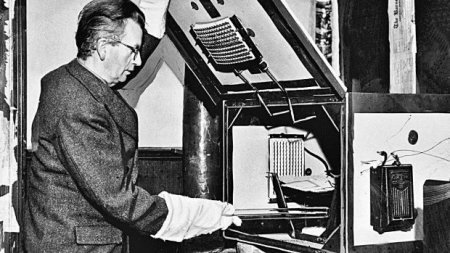
Two years later, in a Daily Express article ('Television in a Music Hall' dated 29th July 1930) A. V. Alexander, First Lord of the Admiralty, mentioned the possibility of television for naval secret signalling. The use of television for this purpose during the Second World War has rarely been mentioned, but on 1st September 1939, the engineer in charge at the BBC's Alexandra Palace, was ordered to cease all television transmissions as of noon. This was two days before Britain and France declared war on Germany. In Germany itself, television (the Reich Rundfunkgesellschaft) continued during the war, stepping up transmissions on an increasing level up to six hours a day. The service was finally closed on 23rd November 1943 when the Berlin transmitter was destroyed by Allied bombing. Although the German programmes were supposedly used to bolster morale, it is entirely possible that they were also used to send secret signals, bearing in mind the German's own interest in this process. This would also make them a prime target for Allied bombers. We are told that the BBC transmitter, more than capable of reaching across the channel, was not used for the duration of the war. But we know, as previously mentioned, that secret signals could also be transmitted in a split second before being halted, meaning that they were almost impossible to detect, especially from a transmitter that was meant to be inactive. We also know that during the Battle of Britain the British used TV signals as a means of jamming enemy bomber guidance systems. The BBC was secretly playing an active part in one of these strategies, but are there more we are unaware of?
There are no records of any television display being undertaken in either the BBC Written Archive Centre or Public Records Office during the War years. However, there is both photographic and film evidence of some sort of activity taking place in August 1943. In this a demonstration is taking place in Studio A. Two engineers are in the photographs along with a female and a child who are the wife and daughter of one of the engineers. Mary Allen, the make-up expert is also featured, along with Douglas Birkinshaw, and Desmond Campbell. Seen at a blackboard is a BBC engineer who was stationed at Alexandra Palace during the war years called "Paff" Pafford. Pafford was one of the engineers who worked on the "beam bending" that is referred to in another article on this website. (see War At The Palace). It can also be clearly seen that the studio equipment was fired-up and working as there are photographs taken off the studio and/or gallery monitors. Desmond Campbell's son, Neil, recalled his father being given petrol coupons to be able to drive the family car down from Daventry (where he was stationed during the War), to Alexandra Palace for a special meeting - possibly with Winston Churchill.
There are, of course, many questions that remain unanswered. Some things are certain: John Logie Baird did pioneer transmissions that were of great interest to the British military as far back as the 1920's. In some way, shape or form, Baird was involved in secret work for the British government during the war years. From his own diaries, it is clear that he had meetings with Sir Frederick Ogilvie, head of the BBC, Admiral Thompson - the Chief Censor, Lord Beaverbrook - Minister for Aircraft Production and many other high ranking officials. One entry, from 1st November 1941, reads: 'Demonstration to Dean, re secret signalling.' During and after the war a secret veil was drawn over these activities.
When in June 1984 a reporter from the Glasgow Herald inquired of the Ministry of Defence about the wartime experiments of Baird, he received the following response: 'No Comment. Much of his work is still classified.'
